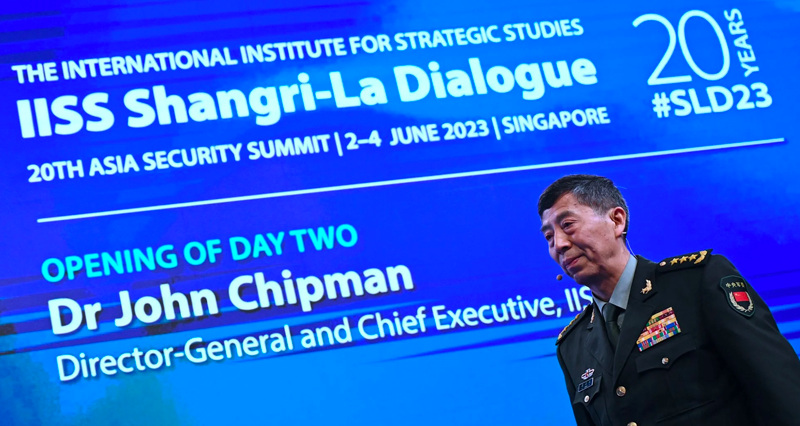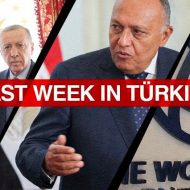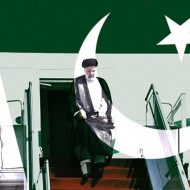By Orçun Göktürk
The 20th Shangri-La Dialogue, held in Singapore from June 2 to 4, revealed important clues about US strategy for NATO expansion in the Asia-Pacific. Originally Chinese, the word Shangri-La means “heaven on earth” or “utopia”. Some have called the meeting “Asia’s Munich Security Summit”. The organizer is the International Institute for Strategic Studies (IISS), a London-based “think tank”. This year’s meeting attracted 48 ministerial-level participants from 41 countries. Most notable participants are defense ministers, politicians, military and intelligence chiefs from 28 countries in the Asia-Pacific region. In addition, high-level participants from outside the region came from the UK, Germany, France, Canada and Israel.
One of the prominent agendas of the meeting was “NATO’s expansion in the Asia-Pacific”. In fact, the agenda of this year’s meeting was set a statement by Japanese Prime Minister Kishida at last year’s Summit. Kishida’s speech last year – “Ukraine today, East Asia tomorrow” – caused a shock. (1) But the biggest obstacle for the US to implement this strategy is the attitude of the countries in the region. A closer look at the details of the Shangri-La Dialogue makes this clear. After Cambodian Prime Minister Hun Sen, who addressed the meeting, said that a global “New Cold War” was taking shape and that NATO’s “Asia-Pacificization” trend was alarming, a number of Asian countries have already begun to warn the US and NATO.
The US and its allies are increasing their provocative behavior by sending warships to the region, especially as Taiwan and the South China Sea have become potential geopolitical conflicts, and are increasing their threats to regional security and stability. Against the US strategy of opening four new military bases in the Philippines, one near Taiwan and the other opposite the Spratly Islands in the South China Sea, the Association of Southeast Asian Nations (ASEAN), one of the region’s most influential actors, is alarmed that interventions from countries outside the region pose a major threat. Although the Philippine government has stipulated that the bases cannot be used for offensive purposes, in the event of a conflict, the Philippines would become a “bridgehead” for the US military to confront major powers.
Japan-NATO rapprochement
An even more dangerous development than the situation in the Philippines and Taiwan is taking place in Japan. The country’s pro-American administration doubled its 2023 military budget. “If there is anything more worrying than the South China Sea, it is the situation in Northeast Asia,” said Singapore’s Defense Minister Huang Yong Hong, referring to Japan’s rapprochement with NATO. Nevertheless, Singapore pursues a “policy of balance” between China and the US in the region. It is notable that a day before the Defense Minister’s statement, Singapore signed an agreement with Japan on “Defense Equipment and Technology Transfer.”(2)
Here are the latest developments in the NATO-Japan flirtation: last month, Koji Tomita, Japan’s ambassador to the US, said that “NATO is planning to open a liaison office in Tokyo.”(3) The liaison office will serve as a base for possible joint, regional US operations with Japan, South Korea, Australia and New Zealand. During his visit to Japan earlier this year, NATO Secretary General Jens Stoltenberg said that “the war in Ukraine threatens the world order” and “the international community is facing changes that will define a new era”. Stoltenberg announced that NATO and Japan had agreed to “deepen their partnership for a rules-based international order”, and stated “both sides will build further support for the situation in Ukraine by increasing the military alliance.”(4)
NATO has been in contact with Japan for a long time. Since 2007, when former Japanese Prime Minister Shinzo Abe visited NATO headquarters, NATO has been planning to open an office in Japan. In 2018, Japan opened a NATO representative office in Brussels, and last year, Japanese Prime Minister Fumio Kishida was invited to the NATO Leaders’ Summit, thus marking the first time a Japanese leader has attended a NATO Summit.
On the other hand, efforts to integrate Japan with NATO countries in bilateral or multilateral formats have already been launched. For example, Japan has embarked on a project with Italy and the UK to jointly develop a new generation of fighter jets by 2035. The aim is to increase the level of interoperability of the Japanese Air Force with the air forces of NATO countries in the coming years. (5)
Objection from Macron
An important reaction to the plan to open a NATO liaison office in Japan came from within the alliance. The British Financial Times reported that French leader Emmanuel Macron, citing NATO’s charter, “opposes NATO’s proposal to open an office in Tokyo because he believes the Alliance should focus on its core North Atlantic region.”(6) The situation seems to have become more complicated for the US with Macron’s remarks that “we would be making a big mistake if we forced a geographical expansion of NATO’s spectrum.”
There are Western experts who argue that the US move would also complicate the situation in Ukraine. The biggest US concerns about the situation in Ukraine is the possibility of China providing military support to Russia. There is growing alarm in the West that this could happen in the scenario of NATO opening an office in Tokyo.
Strong reaction from China
The plan to open a office in Tokyo would be the first NATO naval outpost in the Asia-Pacific, especially in East Asia. China, the main target of the move, has strongly opposed it. Chinese Foreign Ministry spokesperson Wang Wenbin said, ” What is NATO really up to? This calls for high vigilance among countries in the world, particularly in Asia. The attitude of the majority of countries in the region is very clear. They oppose the emergence of military blocs in the region. They do not welcome NATO’s outreach in Asia. They don’t want a replica of bloc confrontation in Asia. And they certainly will not allow any Cold War or hot war to happen again in Asia. NATO needs to have a sober understanding of this.”(7)
The US’ plan for a circle of fire
Japan’s military forces have the 9th largest defense budget in the world, despite being restricted after World War II. Japan’s policies to undermine regional stability, peace and development, and its growing role in US plans to create a ring of fire in the region from Taiwan and the South China Sea to the Pacific coast of East Asia, are increasing the risk of international geopolitical conflict. The current situation makes it clear to the countries of the region, China in particular, that NATO is not only interested in expanding against Russia.
NATO’s strategic target is ultimately China and Russia and all the developing countries of the world. The aim of maintaining US hegemony by force of arms is to consolidate its role as a spoiler in the new international order from the very beginning. The expansion of NATO’s influence is not in the interest of any country in the alliance, especially Europe, except the US. These countries will now have to take on new military and economic obligations.
As for the US strategy in the Pacific through Japan, there is a high probability that the US has other ambitions rather than relying mainly on Japan’s military power. Japan has strong political and military ties with India, Vietnam and the Philippines. Japan is also the third largest foreign direct investor in ASEAN countries after China and the US. We can see from these examples that Japan is critical in the US plan to halt its declining hegemony in the
Pre-war situation?
Some experts in the West and Japan analogize the US-Japan partnership to the Anglo-Japanese alliance of the early 1900s. (8) These commentators note the “brilliant” results of the partnership at the time, including the British and Japanese Empires exploitation of China and opposition to Tsarist Russian expansionism. But the Anglo-Japanese alliance ultimately led to two major wars of division in the 20th century and the creation of a shameful colonial-massacre system in China. In the 21st century, the analogy Western writers have drawn to prevent a world war carries with it the potential for a major catastrophe.
One single front from the Eastern Mediterranean to the Pacific
The most effective method to set a block on this dangerous plan of the US will depend on the stance taken by other rising powers, especially India, in addition to China and Russia. Moreover, the BRICS Summit to be held in South Africa in August will accelerate the geopolitical breakdown.
The US policy on Ukraine, Taiwan and Japan is not independent from its strategy against Türkiye in the Eastern Mediterranean and the Aegean. From the Eastern Mediterranean to the South and East China Seas, it is crucial for the establishment of world peace that the countries targeted by the US take joint initiatives in the coming period and increase their political and economic relations, especially military relations.
Sources
- https://www.theguardian.com/world/2023/may/03/nato-planning-to-open-japan-office-to-deepen-asia-pacific-ties-report
- https://www.mindef.gov.sg/web/portal/mindef/news-and-events/latest-releases/article-detail/2023/June/03jun23_nr3
- https://www.japantimes.co.jp/news/2023/05/10/national/politics-diplomacy/japan-nato-office/
- https://japan-forward.com/nato-deepens-its-partnership-with-japan-as-the-us-expands-military-drills-with-south-korea/
- https://apnews.com/article/japan-uk-italy-fighter-jet-2035-3ed647eee772fa1e622479fffda49801
- https://www.ft.com/content/204e595f-5e05-4c06-a05e-fffa61e09b27
- https://www.fmprc.gov.cn/mfa_eng/xwfw_665399/s2510_665401/202306/t20230606_11090591.html
- James Kaizuka, Japan and NATO: An Inevitable Partnership?. The Diplomat, 8 May 2023.









Leave a Reply